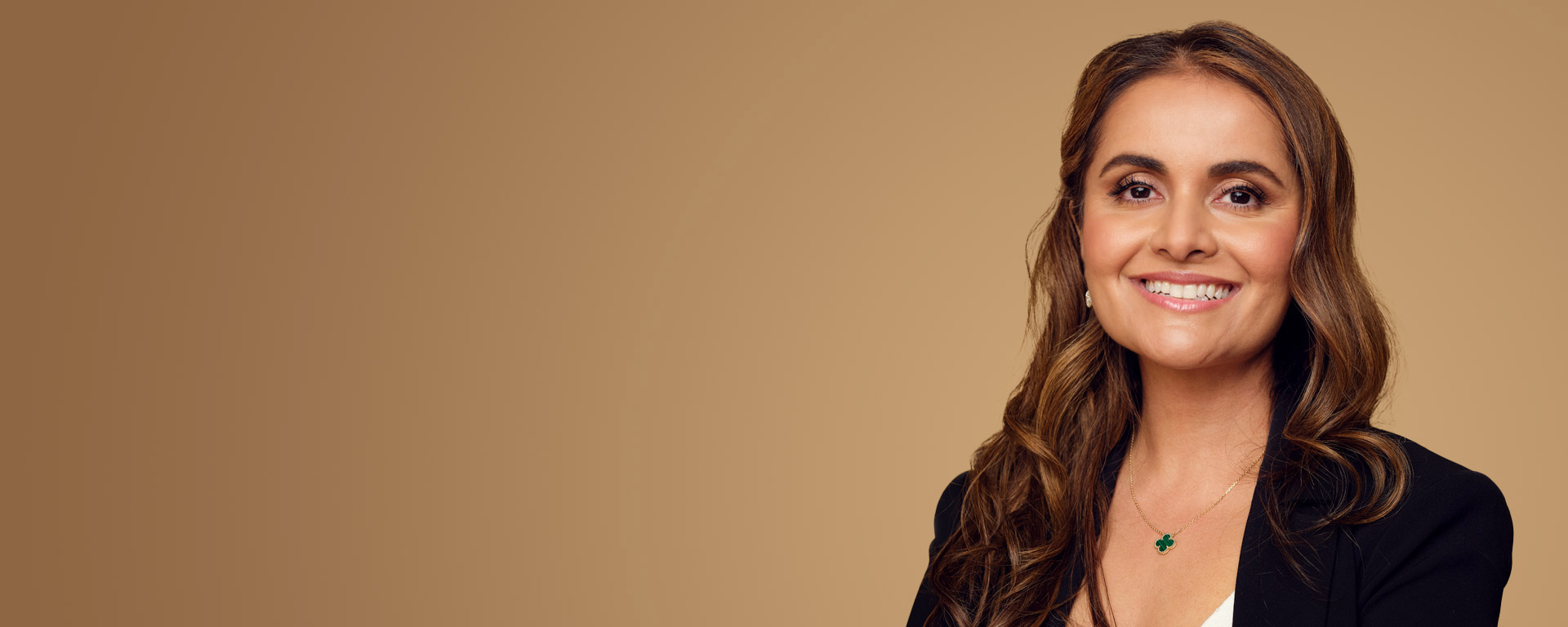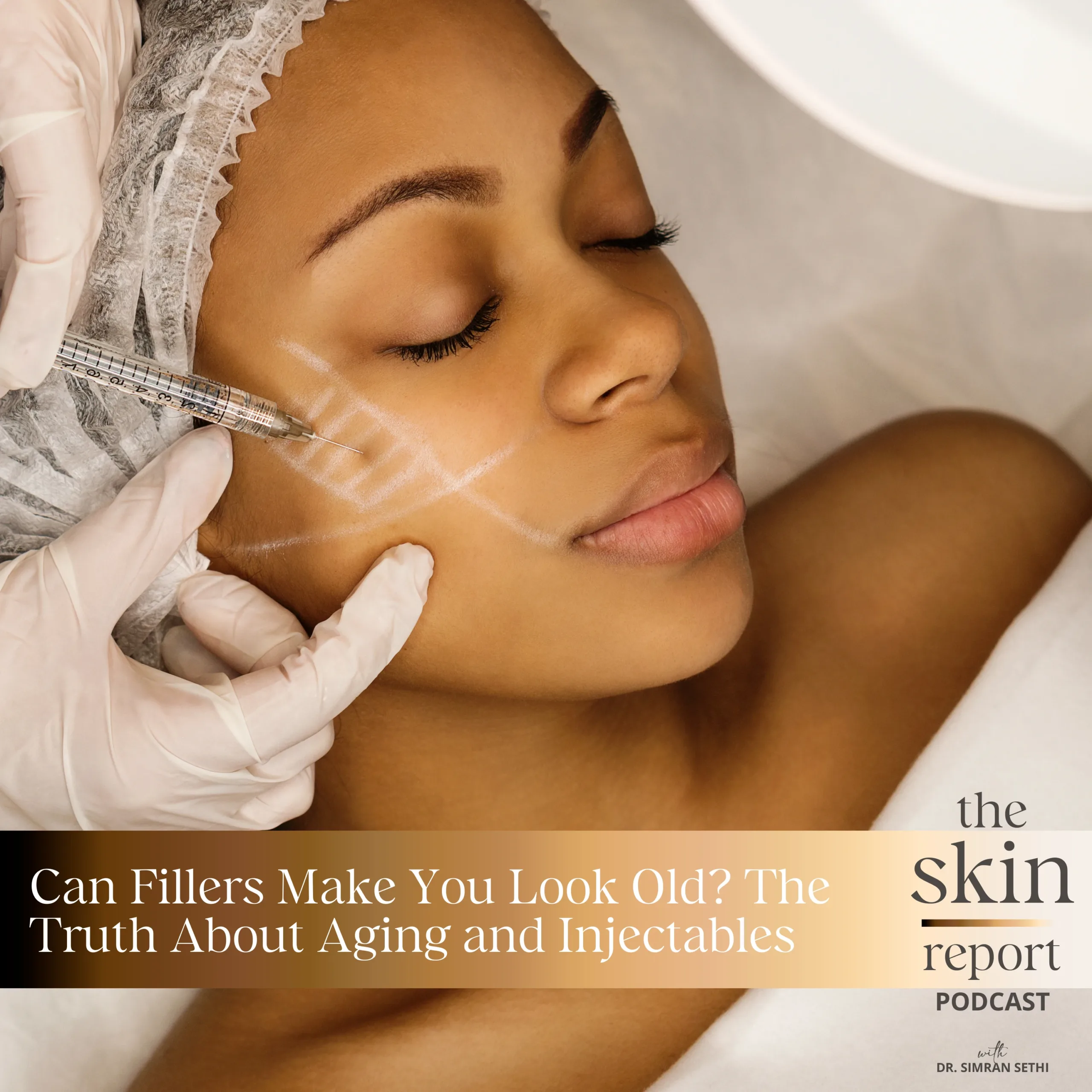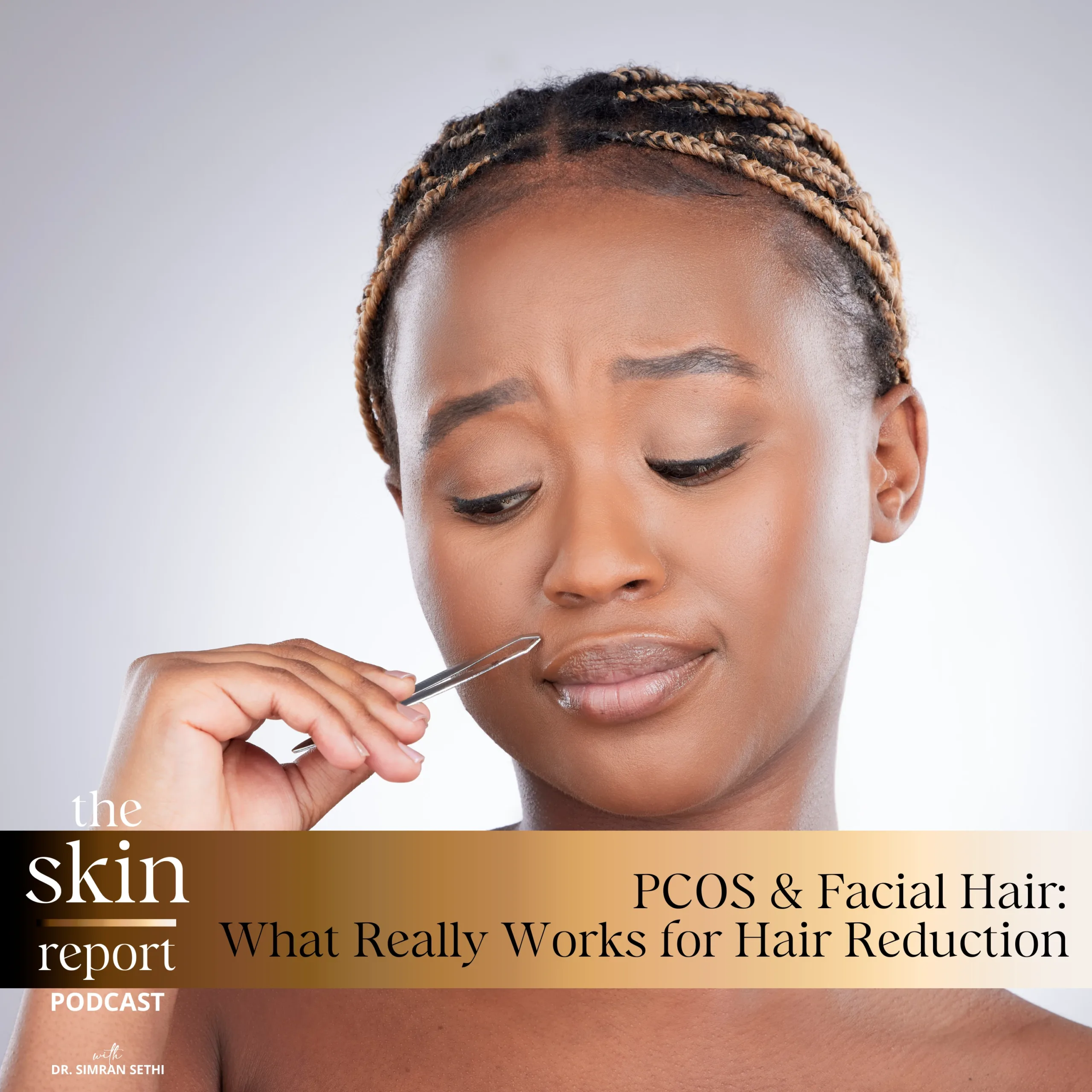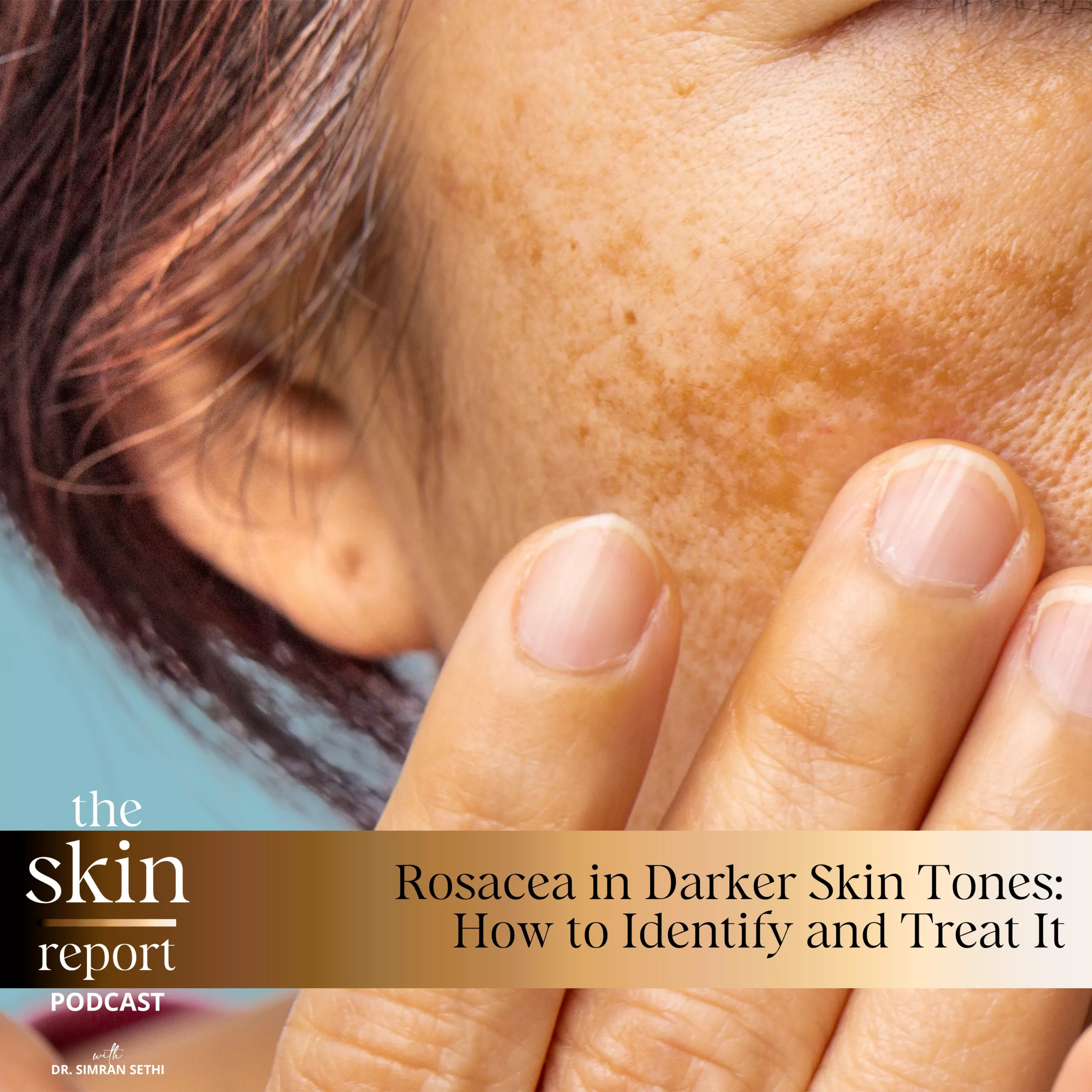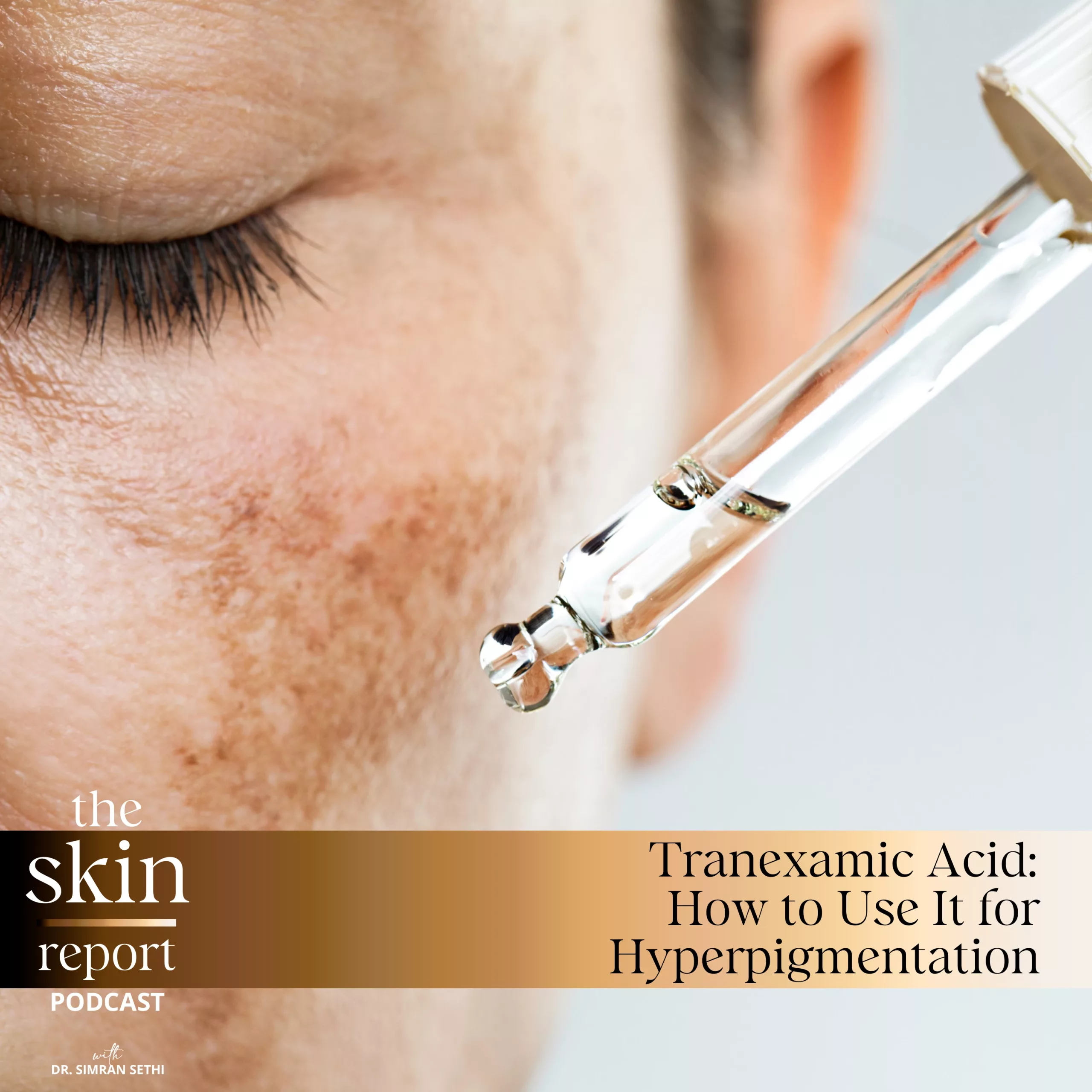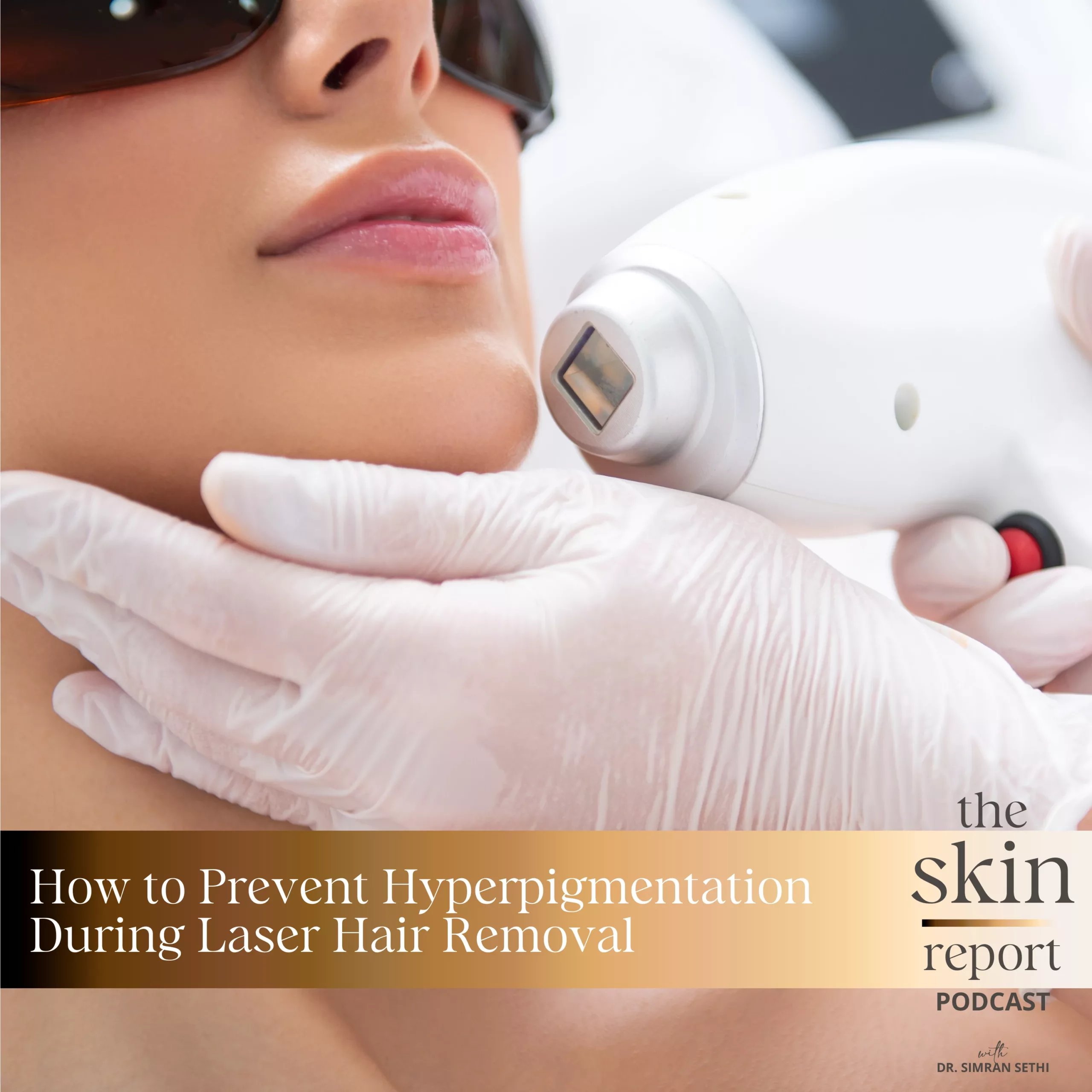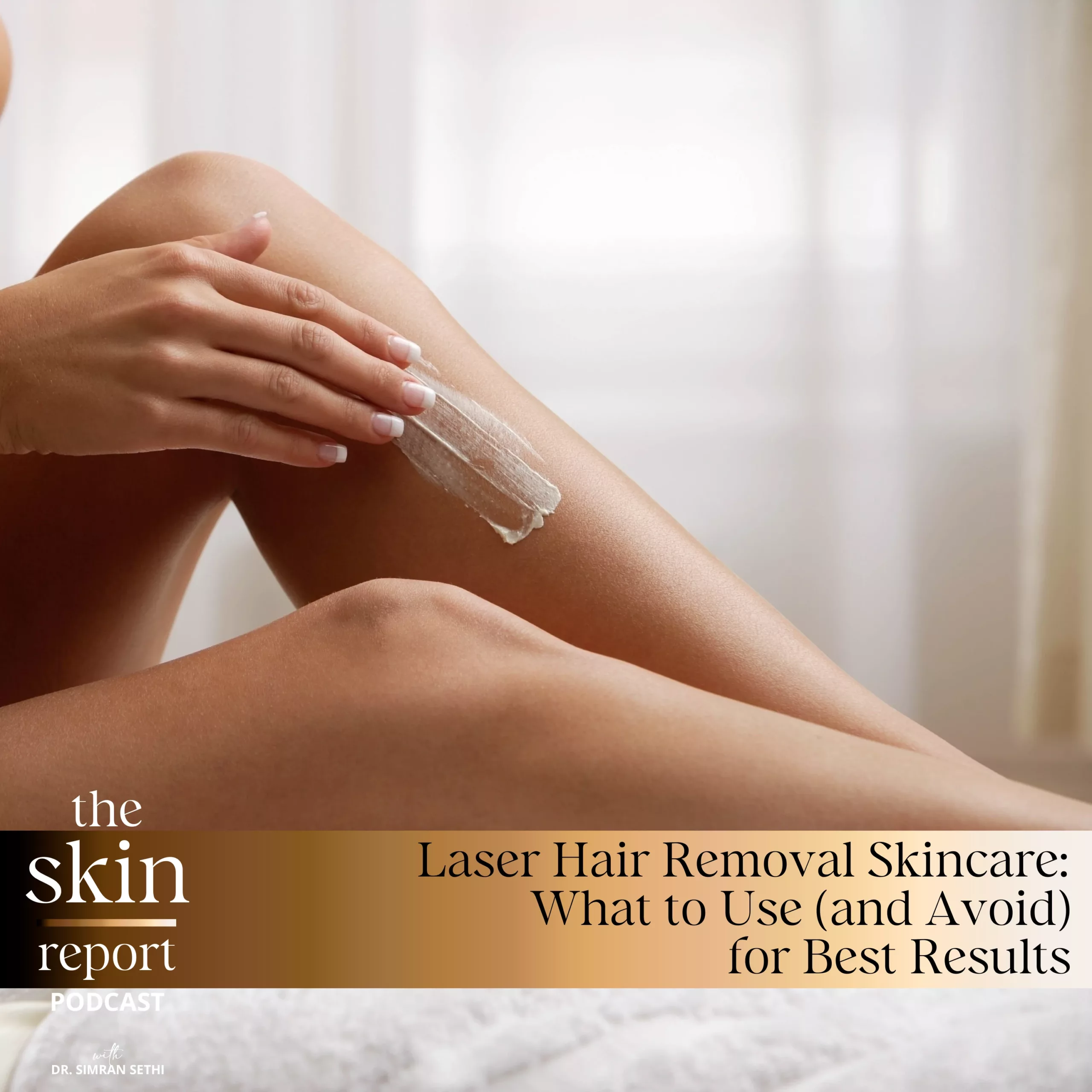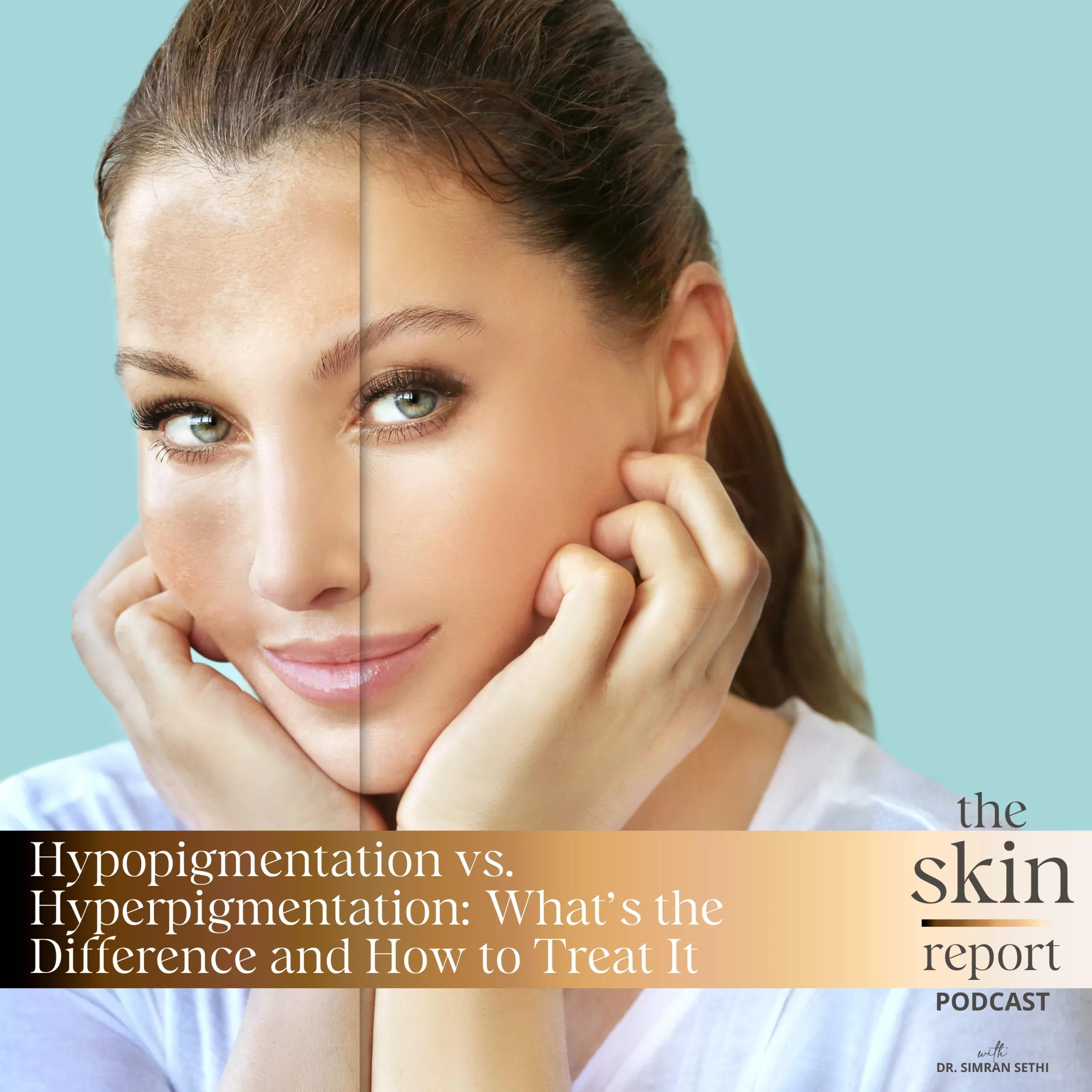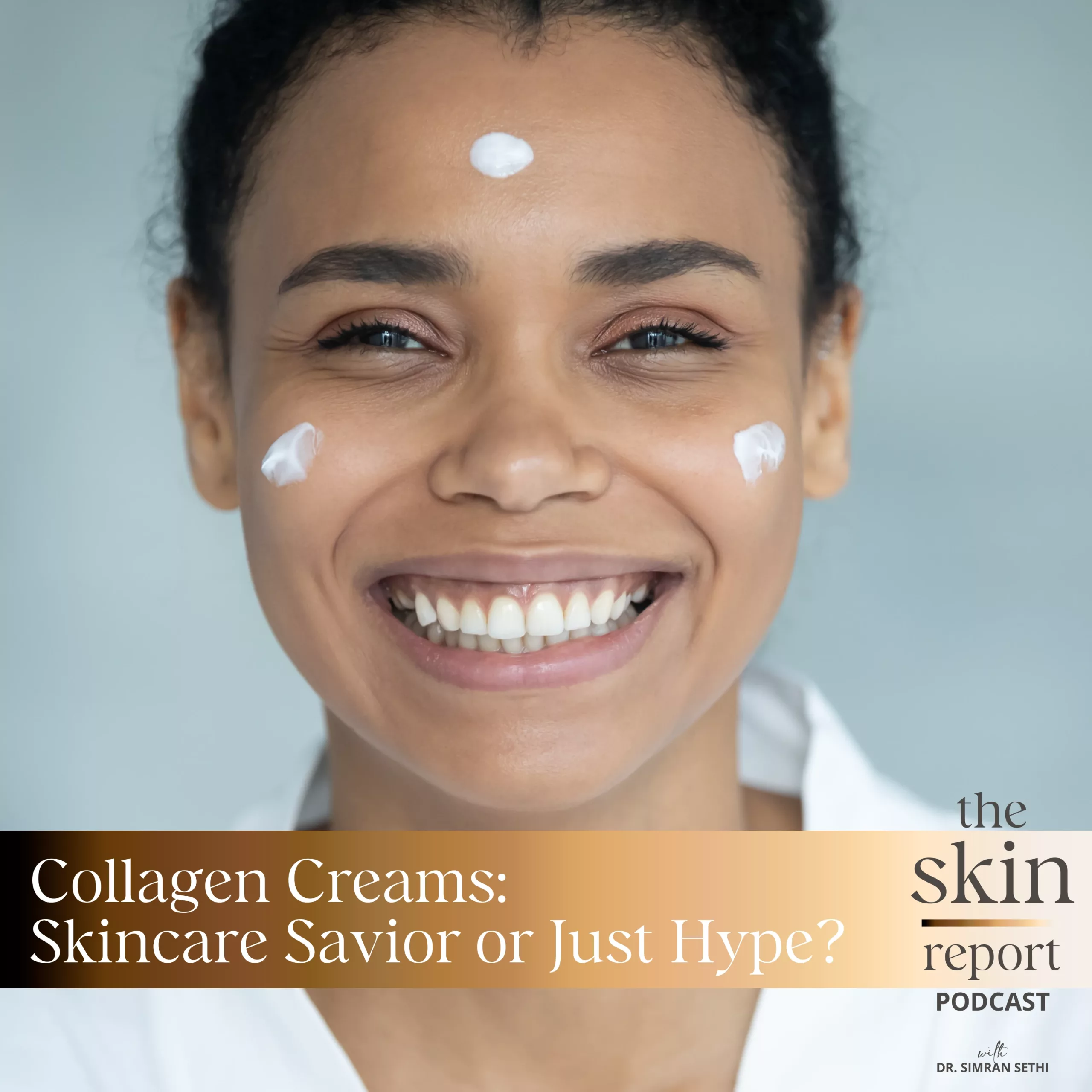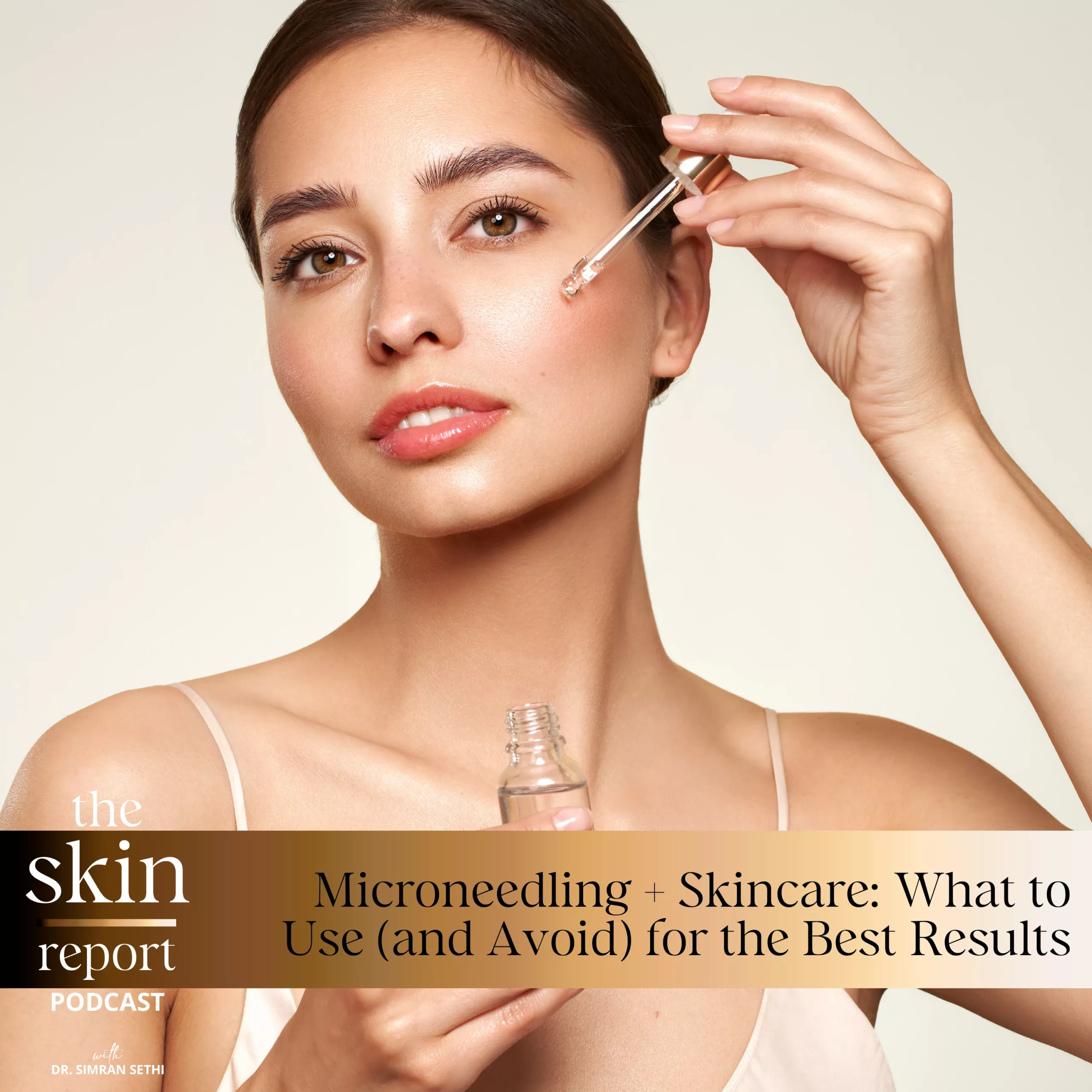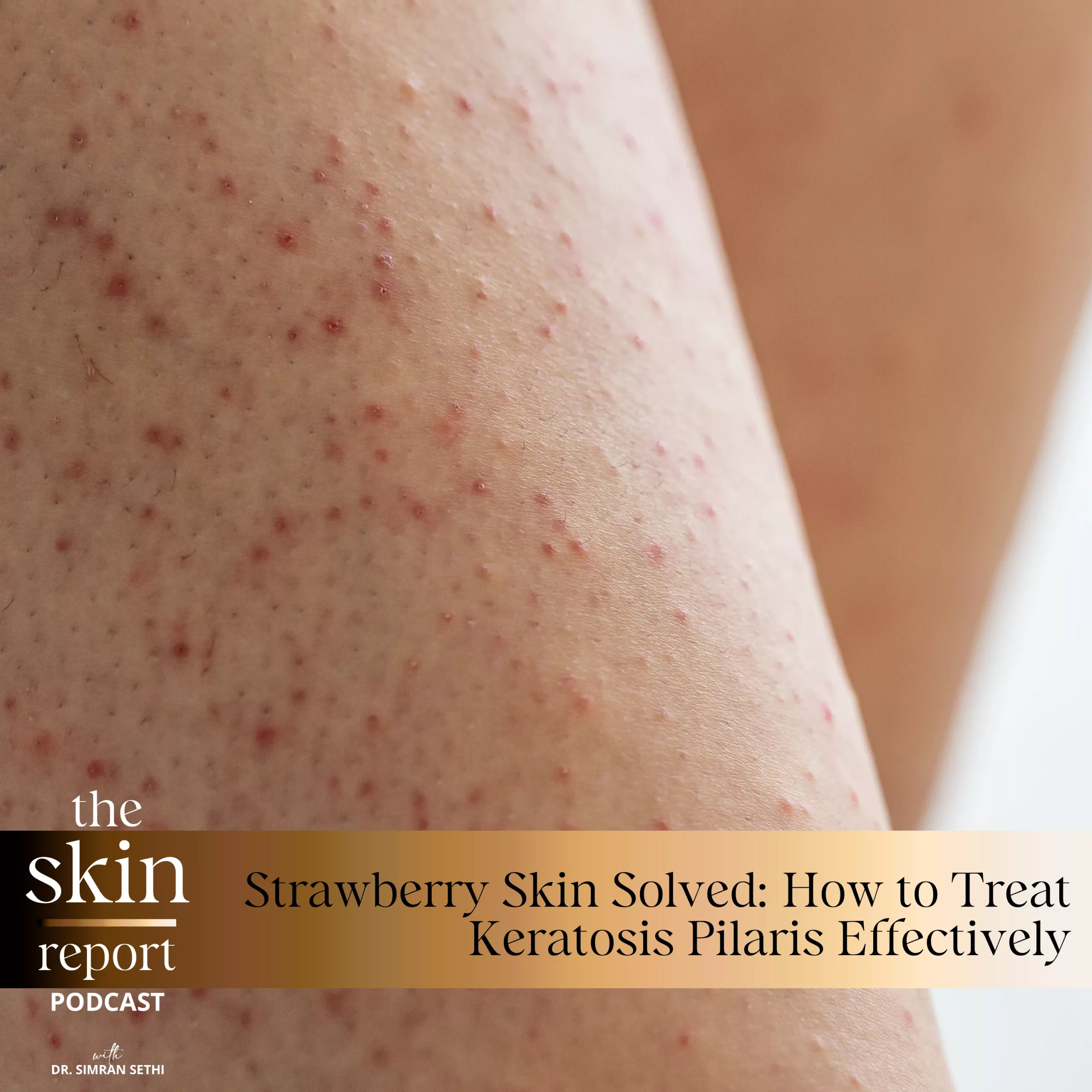Stretch marks are a skin condition commonly experienced during pregnancy. However, it may surprise you that there are different causes of stretch marks, as stretch marks can occur for many reasons other than pregnancy. Of course, many people and beauty companies swear by stretch mark treatments that can “erase” stretch marks. But are these claims too good to be true?
The Skin Report is a podcast created to educate listeners on methods to improve skin health for people of all ethnicities and ages. On this episode, host Dr. Sethi educates listeners on why stretch marks occur, the risk factors for developing stretch marks, and the different types of stretch marks. She also discusses how some aesthetic treatments can lighten stretch marks, making them less visible, while “stretch mark removal treatments” are a waste of money. Finally, Dr. Sethi answers a listener’s question about the different kinds of skin acids, what they do, and when to use them in a skincare routine.
Follow and DM a question for Dr. Sethi to answer on The Skin Report Podcast:
Renew Beauty Instagram:
https://www.instagram.com/renewmd_beauty/
RenewMD Beauty Medical Spas, California:
https://renewmdwellness.com/
RenewMD – Hyaluronic Plump & Protect:
https://skinbydrsethi.com/products/ha-plump-protect
The Skin Report – Pregnancy Skin:
https://theskinreportbydrsethi.com/season-1-episode-16-pregnancy-skin/
The Skin Report – Retinol:
https://theskinreportbydrsethi.com/season-1-episode-32-retinol/
The Skin Report – Types of Exfoliants:
https://theskinreportbydrsethi.com/season-1-episode-14-types-of-exfoliants/
This transcript was exported on January 30, 2023 -view latest version here.
Skin care can feel overwhelming. Whether it’s finding the right products, ingredients, or treatments, there’s a lot out there, but not always for people of African, Hispanic, Middle Eastern, and East and South Asian descent. That’s why I set out to educate myself and others so that we can all feel beautiful in our skin. Hello and welcome to The Skin Report. I’m Dr. Simran Sethi, an internal medicine doctor, mom of three and CEO and founder of RenewMD Medical Spas and Skin by Dr. Sethi.
If you’ve been following the podcast for a while now, you may recall we did an episode on pregnancy skin back in August. If you’re new to the show, you can check season one, episode 16 of The Skin Report to learn more. I bring this all up because today we’re going to be discussing a skin condition most commonly associated with pregnancy, stretch marks. There are actually different causes and types of stretch marks. Tune into this episode to hear more.
According to a study published in NIH, there are different appearances of stretch marks. However, they can be divided into two main types striae or stretch marks. The first type is striae rubrae which represents the earliest stages of stretch marks and appears reddish purple. Over time, striae rubrae become what we called striae alboe which are lighter or hypopigmented, thinner, and more like scars. Stretch marks appear on the abdomen, breasts, upper arms, hips, lower backs, buttocks and thighs.
So, how do stretch marks happen? There are several reasons why they can occur, with the most common being pregnancy. Most times I see people seeking treatment for stretch marks that develop during pregnancy which also tends to be more extensive and difficult to treat or fade. Not every woman who gets pregnant will develop stretch marks, however many do. Studies vary, but most of them claim that up to 90% of women will develop stretch marks.
There are various risk factors for developing stretch marks, including family history. We don’t know exactly how genetics play a role, only that they do, and they do do so significantly. Studies have shown repeatedly that if parents had a tendency toward stretch mark formation, you will too. So, yes, if your mother has deep and dark stretch mark, you are more likely to get them as well. Higher pre-pregnancy body mass index. If you were on the heavier side before your pregnancy, the chances of stretch marks are greater. This may be because you may have some stretching of the skin already due to the heavier weight and the pregnancy girth increases will cause the skin to get even more stretched.
Excessive weight gain during pregnancy, carrying a larger baby and taking the pregnancy to full term or past that, multiple gestation like carrying twins or more, young maternal age. This is really interesting to me. As for most things with our skin, the younger the skin, the more resilient it is to damage. However, a study found that the younger mother’s skin is so strong and tight that when it is stretched, it creates more stretch marks compared to their older counterparts who have more laxity and essentially give in their skin.
Now, stretch marks can occur for reasons other than pregnancy. These are less frequent but still happen because of chronic diseases that require the use of oral steroids. Steroids thin the skin overall which makes stretch marks more common. Some conditions like Cushing syndrome or Marfan syndrome cause stretch marks in various parts of the body. Growth spurts, some people experience light stretch marks during puberty. These are usually present on the upper arms or the back of the legs where we have pubertal growth spurts. Breast enlargement, when breasts undergo enlargement naturally or through plastic surgery, this can cause stretch marks. Muscle enlargement, if there’s a significant increase in muscle size, especially in areas where muscles are not typically very large, like the upper arms, you will see stretch marks.
Before we wrap up this section, I want to mention that darker skin is not more prone to stretch marks, however, stretch marks can be more noticeable in darker skin tones. I also want to add that some treatment options for skin types I through III are not really options for darker skin tones.
With that being said, let’s get into the treatment of stretch marks. Products like cocoa butter, olive oil, and many oils have been touted for years as ways to prevent and reverse stretch marks, but unfortunately, this is simply not effective. Stretch marks occur because the skin is pulled way past its ability to maintain its elasticity and skin barrier. Unfortunately, this means that on a microscopic level, the elastin and collagen fibers are pulled so far apart that they reconnect forming much thinner skin, and no level of skin hydration can prevent this from happening.
Now, I’m going to say something that will sound disappointing at first, but I want you to bear with me as I explain. The goal of this podcast is to offer you science-backed information to help you navigate the millions of beauty and skincare products. With that in mind, I want to say that if there’s any takeaway from this episode is that there aren’t any definitive treatments that erase stretch marks. This is even more true for more melanated skin tones. There are some treatments that can lighten stretch marks so that they’re less visible or are better camouflaged, but we’ll get into this in a little bit.
Okay, there are a lot of creams and oils out there that claim prevention or treatment of stretch marks. Unfortunately, none of them have been shown to prevent or treat stretch marks. These studies have been done in pregnant and postpartum women as this group is most afflicted with stretch marks, and the findings were as follows, a 2012 systematic review of randomized trials that included trials assessing olive oil, cocoa butter, a product containing hyaluronic acid, vitamins A and E, allantoin, essential free fatty acids, and many more ingredients found no high-quality evidence to support the use of these topical preparations to prevent stretch marks during pregnancy. In addition, a subsequent randomized trial of 360 subjects comparing use of olive oil or a cream containing lanolin and some more emollients showed that none of these interventions was effective for prevention.
Many belly band garments to support the abdomen are marketed to pregnant women. However, efficacy of peripartum or postpartum use for preventing stretch marks is unproven. Topical retinoids may be beneficial for the treatment of early stretch marks, but due to fetal safety concerns should not be used for prevention or treatment during pregnancy. A more recent study in 2022 dove into stretch marks and topical treatments as well as laser and radio frequency therapies which we’ll get into in a little bit. This 2022 study published in MDPI, however, still found that no fully effective treatment has emerged.
Overall, you can see there’s a lot of money and time spent by women on these interventions which are really falsely marketed to them without any clinical data supporting efficacy. However, there are some aesthetic treatments that had varying success, such as ones I’m about to dive into and which were mentioned in the 2022 study. So, if a patient comes with stretch marks they’d like to fade away and treat, what do you do? We’ll answer that when we return.
When a patient comes to my office seeking treatment for stretch marks, the first thing I do is examine the marks to classify them as mild or moderate to severe. I then factor in their skin color to put together my recommendations. For mild stretch marks on all skin tones, I will start the patient on a 1% retinal and recommended series of 6 to 8 microneedling sessions. This won’t completely eliminate all stretch marks but will lighten them and make them thinner. We have an episode on retinol and microneedling each which I will link down below in the show notes.
For moderate to severe stretch marks and lighter skin tones, again, I start them on a 1% retinol. If the stretch marks are red or purplish in color, I will recommend a series of pulse dyed laser treatments to them. However, this will only lighten the color of the stretch marks to make them less obvious, and these laser treatments can cost between 3000 to $4,000, so I always make sure that the patient understands the limited improvement they will see for that level of investment.For moderate to severe stretch marks and skin types IV to VI, I also start with 1% retinal, but I offer 4 to 6 sessions of microneedling with radio frequency instead of the pulse dyed laser. Pulse dyed lasers and fractionated lasers have a high risk of hyperpigmenting the stretch marks in darker skin tones and should never be used in this skin type. Even still, the cost of these treatment ranges between 5,000 to $6,000 and will yield limited results. It’ll only slightly lighten the stretch marks and tighten the skin to some extent, but in my opinion, it’s really not worth the investment. Again, it’s not my place to judge what is considered a good investment in money and time when it comes to my patient’s goals, but if a patient asks me my opinion, I will give it, especially in a case like this where treatment options currently are just not advanced enough.
Over the years and even when I was pregnant, I’ve seen so many creams and oils marketed to pregnant women and they just don’t have the data to support themselves. When I was pregnant, I used products like Bio Oil and a few others that felt great on my skin, but I don’t think did anything to limit stretch marks. Skincare is an investment, and while it may sound discouraging, I’d rather you know that you don’t need to spend thousands of dollars on creams that ultimately don’t work. Instead, consider waiting until postpartum and seeking out other options from there, and with time, stretch marks can also fade. However, if you want to hurry along the process, procedures like microneedling can help.
Recently, a listener asked if I could cover the different types of skin acids, what do they do, and when should they be used. This is an excellent question because there is so many acids out there for skin, and how do you know what is right for you and when. First of all, when we think of acids, we think of a product that will sting or burn the skin. This may cause us to automatically shy away from using them or use even more of them depending on what we’re trying to achieve. I’m going to cover the top acids in skincare, their benefits, and who should consider using them.
First, let’s cover hyaluronic acid which is my favorite and is a product that every skin type and skin tone should be on. Hyaluronic acid is a molecule that is naturally found in our skin and its job is to hold onto water. Hyaluronic acid holds onto a thousand times its weight in water so that we can keep our skin moist and protect our skin barrier. So, contrary to the idea that acids eat away or burn, HA actually helps hydrate. The key to using hyaluronic acid or HA is applying it on top of all your skincare, so it’s the last step before applying sunblock so that it can lock in all your moisture and natural oils to give your skin a healthy and plump appearance.
In my skincare line, the hyaluronic acid Plump & Protect is included every skincare system for oily, dry, acne-prone, and dull skin because it’s an essential product in protecting our moisture and skin barrier no matter what skin type and tone we have. In my case, I have oily skin and found that after a few hours of washing my face, I would have a really oily T-zone. I would then dab it with a tissue or apply a mattifying powder. Ever since I started applying hyaluronic acid above my skincare, I’ve never had to dab oil off my skin throughout the day and at night.
The next acid I want to tackle is actually a group of acids that work as chemical exfoliants. Yes, I want to talk about glycolic, lactic, alpha hydroxy, and beta hydroxy acids. These acids can be found in cleansers, chemical peels, gels, and creams, and help slough off dead skin cells and debris from the skin surface and deeply cleanse pores too. To hear more about the difference between chemical and physical exfoliants, check out episode 14 of The Skin Report. For now, I will say this, the most important thing to keep in mind with these acids is their concentration which determines how strongly they exfoliate. If you’re using a highly concentrated AHA or BHA on a daily basis, this can break down your skin barrier and make your skin feel red and sensitive. In more melanated skin tones, it will make your skin appear darker.
Some people think that if a product burns your skin on application, it’s working well. This is simply not true, and there is a high risk of this happening if we are too aggressive with a class of acids in our skincare regimen. A burning sensation on your skin is indicative of a compromised skin barrier and signals the need to stop exfoliating daily or lower the concentration of the exfoliant, and add more lipids to your skin regimen in the form of ilipid or phospholipid rich serum or cream.
Lastly, I want to tackle retinoic acid. This is the same as retinol, and we have an episode explaining the benefits of retinols and what to avoid, which will be linked below. We covered a lot in this episode, and when it comes to stretch marks, I probably left you pretty disappointed, but as it is something that many patients want solutions for and I do too personally, I’m always going to be on the lookout for safe and effective treatments and be sure to report back to my patients and listeners. Finally, I know we also did a quick breakdown of common acids found in skincare, but I hope it still helps you understand that all the acids discussed are great options for our skin if used at the right concentration and steps in our skincare. Thanks for listening today, and until next time, love the skin you’re in and celebrate your beauty.
If you’d like to learn more about science-backed skincare or medical aesthetic treatments, please subscribe to and turn on notifications for The Skin Report so you always know when a episode is up. We have a newsletter that you can sign up for on theskinreportbydrsethi.com so that you can stay up to date on all our new episodes, blogs, products, and more. Additionally, if you have a skincare question or want to make an episode topic recommendation, please message me at theskinreportbydrsethi.com which is linked in my show notes, and I’ll be sure to answer your question in an episode soon. We’ve received some great questions so far and I will try and answer them at the end of every episode, so keep them coming.
Transcript by Rev.com

